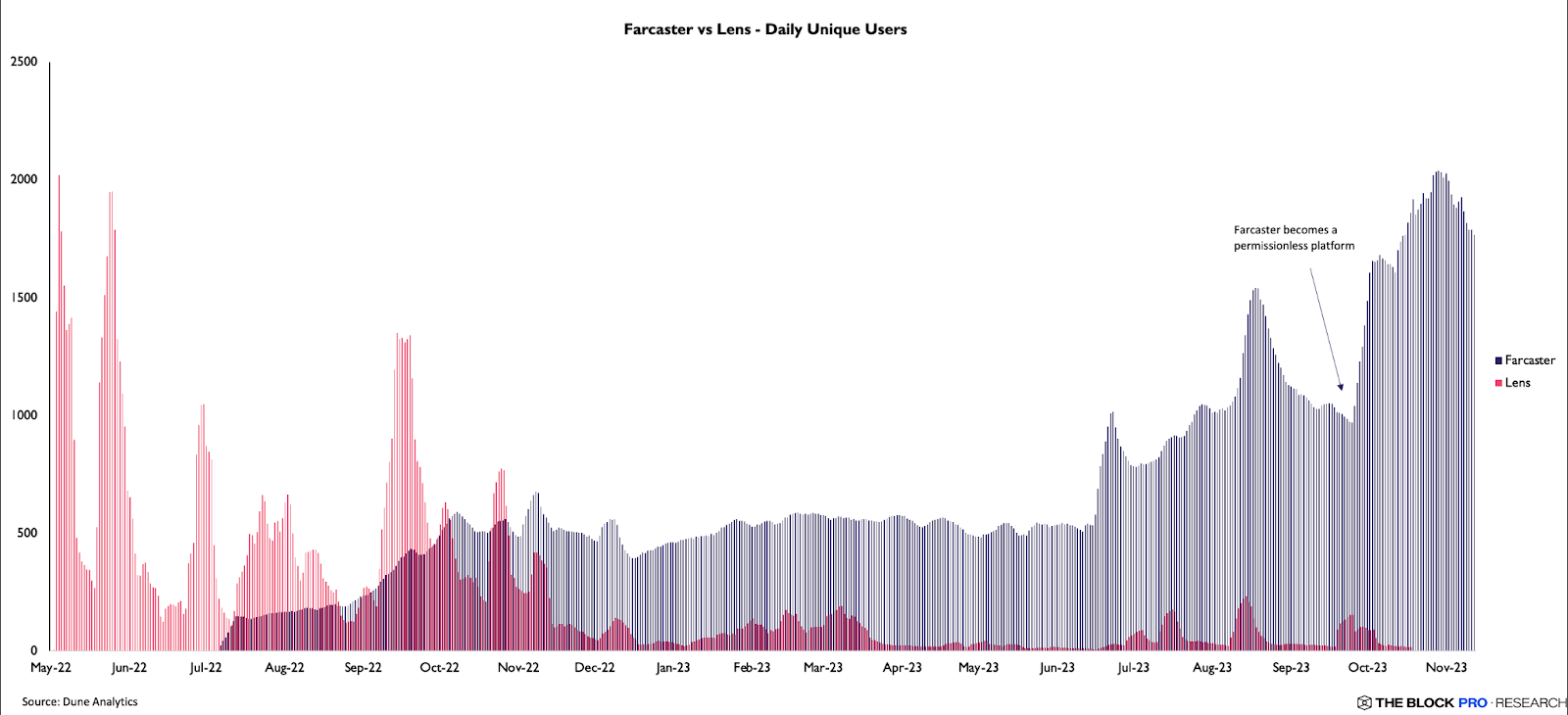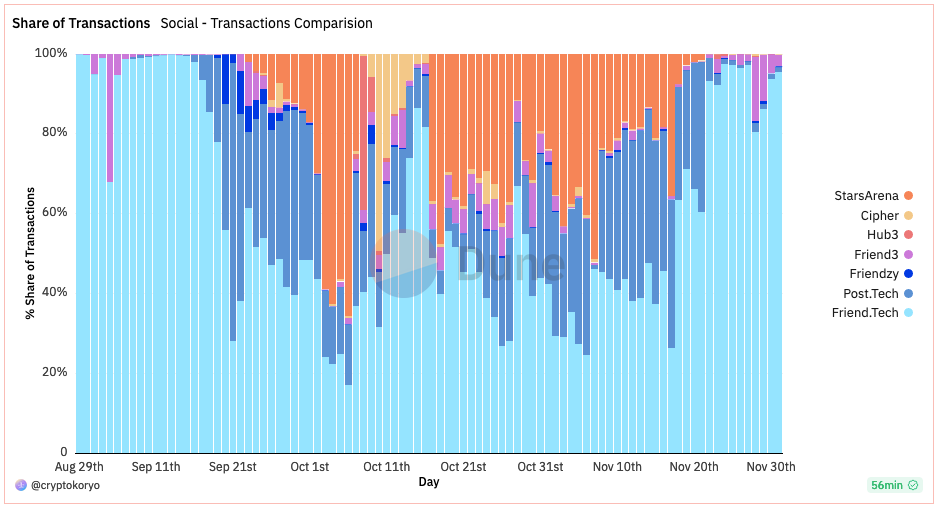The Block: A Review of the Web3 Social Track in 2023
Original Title: 《 How crypto social media apps developed over the last year》
Author: Tim Copeland, THE BLOCK
Translator: Elvin, Chaincatcher
Abstract:
- Decentralized crypto social media applications have made positive progress this year, focusing on scalability and opening up to more users.
- The attention on social finance platforms has surged, but they have failed to retain users.
This year marks a significant step forward for a new wave of crypto social media applications, with some apps opening access while others have gained considerable traction.
Such applications can be broadly categorized into two types, with some overlap. The first is the so-called "decentralized social," which includes social media applications running on decentralized networks, designed to give users more control over the applications and avoid being managed by a single centralized entity.
The second category is referred to as "social finance," where applications embed crypto features in a very direct way, bringing monetization to the core of the applications. FriendTech leads the development of such applications.
Decentralized Social Apps Opening Up
Due to the complex infrastructure that decentralized social applications rely on, which is still under development, these applications often have restrictions for new users. However, as these platforms become more confident, they are starting to open their doors to a wider audience.
For example, Ethereum co-founder Vitalik Buterin has spent much of his time on the decentralized social media application Farcaster, which became completely permissionless in October, meaning anyone can use the platform.
"This year, decentralized social has moved from the alpha phase to the beta phase, with Lens and Farcaster entering a more open and ready-to-scale stage, making 2024 a year to understand the actual needs of users as we move away from whitelists and strict quotas," said Joonatan Lintala, CEO of the Lens-based social media platform Phaver.
"To some extent, it's unfortunate that it took so long to get there, but bear markets are for hibernating and getting things done, so the timing should actually be good. Now it's up to Phaver and other user-layer applications to figure out how to put these charts into good use and truly add value for users, including those outside the crypto bubble," he added.
While Lens has not fully opened its doors yet, it has made significant progress this year. In April, it launched Momoka, enabling it to move large data storage off its running Polygon blockchain. This move aims to enhance its scalability. In July, it launched the second version of the protocol, offering a broader range of features.
Despite these improvements, Lens still lags behind Farcaster in adoption, partly due to Farcaster's completely open doors. According to a research report from The Block Pro in November, Lens has 126,000 profiles, while Farcaster has 196,000 registered IDs.

The daily user count of Farcaster has rapidly increased. Image: Block Pro/Dune Analytics.
"Farcaster is known for attracting users seeking quality discourse and a community-oriented environment. In contrast, while Lens offers rich features for creators, current engagement levels are lower," noted Brad Kay, a researcher at The Block Pro.
Social Finance Emerges but Quickly Falls
While decentralized social platforms are slowly expanding, social finance platforms have emerged and rapidly developed.
FriendTech is an original application that integrates financial engineering. It provides a space where users can purchase keys to access closed group chats of influencers. The price of the keys follows a curve, meaning the more keys purchased, the more expensive the keys become. What about the kicker? A 10% fee is charged on each transaction, shared between the platform creators and influencers.
This financial incentive model has sparked a lot of speculation. According to a Dune dashboard created by a data analyst named Crypto Koryo, since its launch in August, 843,000 users have spent a total of $267 million in Ether across 12 million transactions. According to DefiLlama, this has generated $59 million in fees, half of which is distributed among its user base. Although activity has decreased in recent months, the platform still has $35 million locked in its smart contracts.
"The massive growth we saw in September was astonishing. Similarly, without new retail and in a bear market, FriendTech was able to generate more revenue in a short time than the largest DeFi protocols like Uniswap, Lido, and even the Ethereum chain itself," Crypto Koryo pointed out.
The activity is driven by two themes. First, users want to make quick money by purchasing keys and reselling them at a higher price. The binding chain mechanism means prices can quickly become expensive, offering potential high returns but also the risk of losses due to bad trades and high fees. A user named Vombatus made nearly $2 million by accumulating his keys and then dumping them all at once to users who also purchased his keys.
The second hypothesis is that the platform will airdrop at some point based on activity. This concept is supported by the platform's points system, which awards points to users based on their activity, leading many users to speculate that this will be used to determine eligibility for potential airdrops. So far, this has not happened.
"Once FriendTech becomes 'mainstream,' it will be interesting to observe the behavior of different groups. After most of 'Crypto Twitter' joined, we began to see non-crypto native groups joining, such as OnlyFans members, musicians (including Pussy Riot), sports stars, and even Web2 media companies," Crypto Koryo added. "This is because monetization is an issue for content creators in both Web2 and Web3."
Following the success of FriendTech, other platforms have emerged, offering similar products. Stars Arena, based on Avalanche, is one of the most popular games, but it has struggled to regain momentum after experiencing a $2.9 million exploit and internal team disagreements. Other applications, such as New Bitcoin City based on Bitcoin Layer 2 NOS, offer far more features than FriendTech, but none have been able to attract a similar user base. These applications now have much lower daily transaction volumes, while FriendTech remains in the lead.

Stars Arena had higher daily transaction volumes than FriendTech at its peak, but this did not last long. Image: Dune Analytics/Crypto Koryo.
Looking Ahead
While introducing decentralization and cryptocurrency into social media has been challenging both technically and in creating sustainable financial mechanisms, it seems that there is indeed a potential audience for such approaches.
Saurabh Deshpande, a researcher at the crypto communications platform Decentralized.co, pointed out on Twitter: "Blockchain as a payment rail means Web3 social networks can reward global users without platforms exploiting user data or serving ads."
Deshpande added that the core concept of compensating users for the content they post on social networks is indeed valuable.
He noted, "We haven't reached this goal yet, but we will gradually achieve it by leveraging features like ownership, composability, permissionless access, and censorship resistance."











